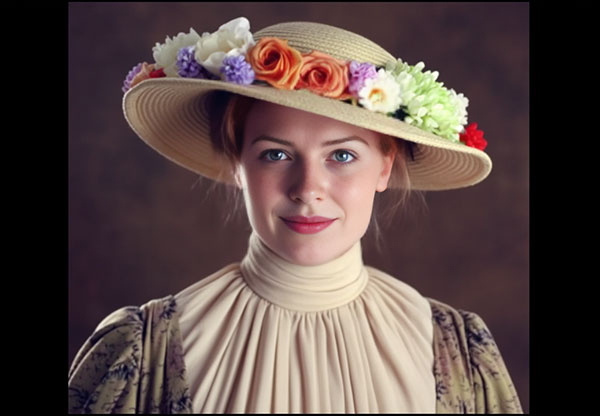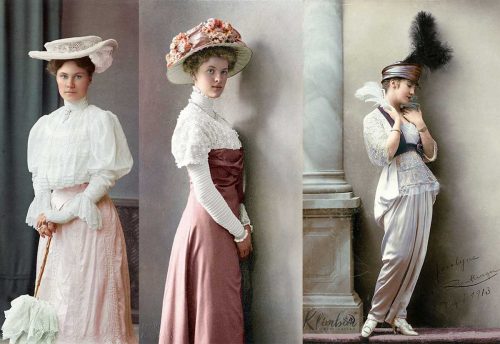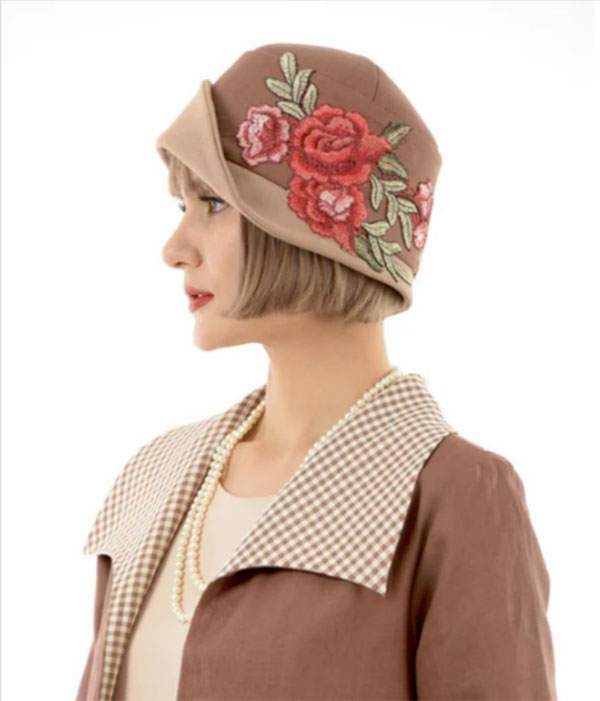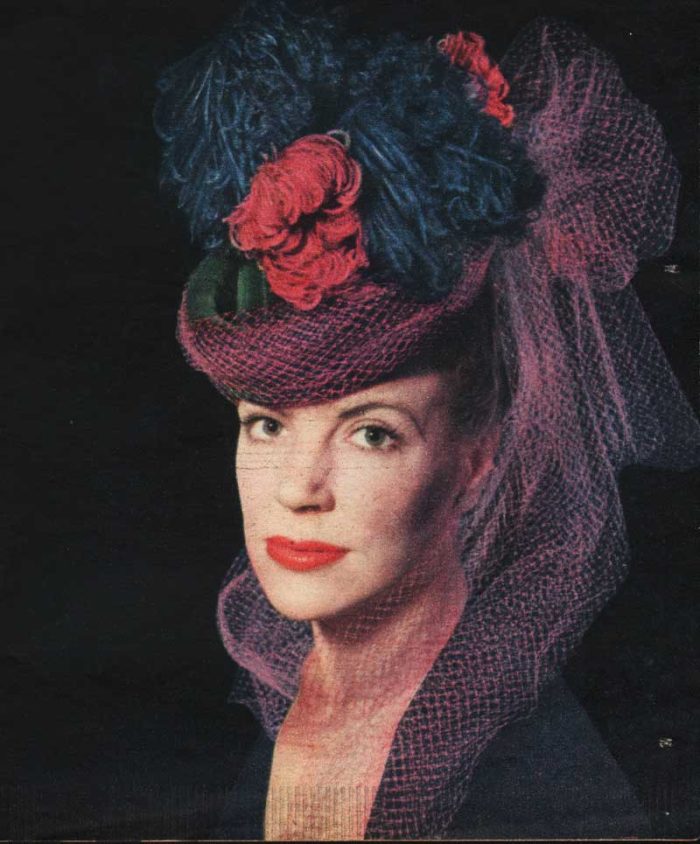Trace the vintage charm of floral hats in women’s fashion. Explore how blooms shaped trends from the Edwardian era to the 1940s.
Hats With Flowers: From the Edwardian Era to the 1940s
The history of fashion reflects societal shifts, technological advancements, and cultural changes. Nowhere is this more evident than in headwear. Hats have played a pivotal role in fashion from the Edwardian era (1901-1910) through the 1940s.
One of the most delightful trends during this period was the adornment of hats with flowers. They added a touch of nature’s beauty to a woman’s ensemble. This article from My Global Flowers explores the evolution of floral hats from the Edwardian era to the mid-20th century. Let’s trace their journey through changing fashions, social norms, and artistic movements.
Edwardian Elegance: 1901-1910

The Edwardian era, named after King Edward VII of the United Kingdom, marked a period of elegance and opulence. Fashion of the time mirrored the prosperity experienced by the upper classes and the nouveau riche.

The style of flowers during this era was heavily influenced by the Aesthetic Movement, which celebrated beauty in nature. Large hats with extravagant blooms—both real and artificial—became a staple. Orchids, peonies, and roses were particularly favored. Crafted from high-quality materials like silk and velvet.
Milliners of the time, often women themselves, used innovative techniques to create elaborate floral arrangements on hats. Including wire framing for structure and fabric manipulation for realism. This gave rise to hats that resembled floral headdresses, transforming the wearer into a living embodiment of femininity.
The quintessential Edwardian hat was the “picture hat,” characterized by its wide brim and elaborate decoration. Often the subject of public fascination, these hats served not only as accessories but also as social commentary on the status of women. During a time when women’s rights were gaining momentum, the flamboyant floral hats became a symbol of the progressive spirit.
The Great War and the 1920s: Transformation and Resilience

The outbreak of World War I in 1914 brought significant changes to fashion and societal norms. With many women entering the workforce, the extravagant styles of the Edwardian era gradually gave way to more practical designs. However, flowers remained a crucial element in women’s headwear, albeit with a shift in style and presentation.
During the war, hats began to reflect the realities of life, with floral embellishments becoming more subdued. Milliners employed simpler designs using fewer flowers, often favoring more muted colors to reflect wartime austerity. Nonetheless, these hats maintained their charm; flowers were often hand-made from leftover fabric to support the war effort, symbolizing both thriftiness and creativity.

As the 1920s rolled in, a new era of fashion emerged with the flapper movement, characterized by a desire for freedom and independence. The informal look of the 1920s introduced a variety of hat styles, including cloches and bobbed cuts, yet floral adornments remained a captivating feature. Hats turned to smaller, decorative appliqued styles with simple floral accents, often incorporating materials like netting and feathers.
The 1930s: Embracing Glamour During Hard Times
As the Great Depression of the 1930s set in, fashion found a way to flourish despite economic hardship. The industry embraced escapism, which was evident in the lavish designs of the hats. Floral embellishments grew bolder, often featuring large statement flowers, which served as symbols of vitality and resilience.

This era was characterized by a return to femininity and elegance, heavily influenced by Hollywood glamour. Movie stars showcased extravagant hats, often with oversized flowers, in films that celebrated romance and opulence. On the street, the cloche was replaced by the sporty beret, often worn with a net veil. Milliners also experimented with colors and textures, using contrasting fabrics to enhance floral motifs.
The fashion magazines of the 1930s played an integral role in popularizing floral hats. Publications like Vogue and Harper’s Bazaar featured covers showcasing glamorous models in floral-adorned hats, capturing the imagination of women everywhere. This period marked a transition where hats became not just functional but essential components of high fashion.
The 1940s: War and Utility

By the late 1930s and into the 1940s, the world was again engulfed in war, with World War II drastically altering the landscape of fashion. The chaos of the war necessitated a shift toward practicality and functionality. With many fashion houses focusing on war supplies, the ornate hats of the past gradually gave way to simpler designs.
The government imposed rationing, which affected the availability of materials and luxury items. However, women continued to wear hats adorned with flowers, albeit in a more utilitarian style. Simple fabric flowers became a popular choice, often crafted from scraps. Floral hats of the 1940s reflected a sense of patriotism, with colors reminiscent of national flags or symbolic flowers like red poppies to honor the lost.
Despite the necessity for practicality, the 1940s also initiated a sense of rebellion against the scarcity of materials. The later part of the decade saw the re-emergence of bold floral designs, albeit in a more artistry-driven manner. Women started to mix and match floral accessories, demonstrating their creativity even in challenging times.
Why Floral Hats Could Become a Trend Again

With current movements towards vintage fashion and sustainability, floral hats are positioned for a resurgence. Here are several reasons why floral hats can become a trend now:
- Nostalgia for Historical Fashion: As fashion cycles through eras, there’s a growing appreciation for the intricate designs of the past—especially with vintage aesthetics gaining momentum.
- Sustainable Fashion: The focus on sustainable materials and handmade goods has paved the way for hats crafted from natural fibers and adorned with real or artisanal flowers.
- Versatile Style: Floral hats can add a unique twist to contemporary outfits, elevating everyday looks and making casual attire feel more sophisticated.
- Personal Expression: In a time where individuality is celebrated, floral hats allow wearers to express their uniqueness and creativity.
- Social Media Influence: With platforms like Instagram and Pinterest, vintage-inspired styles are easily shareable and can quickly gain popularity.
- Event Wear: As social gatherings and events return post-pandemic, floral hats are ideal for outdoor ceremonies, picnics, garden parties, or even music festivals.
- Seasonal Appeal: Floral designs inherently evoke feelings of spring and summer, making them perfect for seasonal wardrobes and celebrations like weddings and anniversaries.
The Legacy of Floral Hats
The history of floral hats from the Edwardian era to the 1940s is a fascinating journey through society’s changing perceptions of beauty, gender roles, and personal expression. These hats evolved from symbols of elegance and status to representations of resilience and practicality amid the trials of two world wars.
Today, floral hats remain a beloved fashion accessory, celebrating the enduring spirit of creativity and individuality. From Kate Middleton’s wide-brimmed hats at royal events to the contemporary fashion trends on runways around the globe. The floral hat stands as a testament to the essence of femininity and the beauty of nature.
As we look back on this rich history, we recognize that flowers in headwear are not just decorative elements, but powerful symbols of the times they reflect: passion, struggle, resilience, and ultimately, an unyielding pursuit of beauty.
That’s all ! ©Glamourdaze.com





